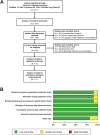Reducing early pregnancy loss with vitamin D3: an analysis of serum 1,25-(OH)D3 modulation and miscarriage risk
- PMID: 40151409
- PMCID: PMC11936736
- DOI: 10.3164/jcbn.24-147
Reducing early pregnancy loss with vitamin D3: an analysis of serum 1,25-(OH)D3 modulation and miscarriage risk
Abstract
This case-control study of 124 early-pregnant women found that daily supplementation with 400 IU of vitamin D3 significantly increased serum 1,25-(OH)D3 levels and was associated with a lower incidence of threatened miscarriage. The study suggests that vitamin D3 supplementation could reduce the risk of early miscarriage and improve pregnancy outcomes by modulating immune responses and hormonal stability.
Keywords: early pregnancy loss; immune modulation; miscarriage prevention; serum 1,25-(OH)D3; vitamin D3 supplementation.
Copyright © 2025 JCBN.
Conflict of interest statement
No potential conflicts of interest were disclosed.
Figures











Similar articles
-
Effect of vitamin D3 supplementation in pregnancy on risk of pre-eclampsia - Randomized controlled trial.Clin Nutr. 2019 Apr;38(2):557-563. doi: 10.1016/j.clnu.2018.02.023. Epub 2018 Mar 2. Clin Nutr. 2019. PMID: 29550150 Clinical Trial.
-
Pharmacokinetics of high-dose weekly oral vitamin D3 supplementation during the third trimester of pregnancy in Dhaka, Bangladesh.Nutrients. 2013 Mar 12;5(3):788-810. doi: 10.3390/nu5030788. Nutrients. 2013. PMID: 23482056 Free PMC article. Clinical Trial.
-
Vitamin D3 supplementation during pregnancy and lactation for women living with HIV in Tanzania: A randomized controlled trial.PLoS Med. 2022 Apr 15;19(4):e1003973. doi: 10.1371/journal.pmed.1003973. eCollection 2022 Apr. PLoS Med. 2022. PMID: 35427363 Free PMC article. Clinical Trial.
-
Effects of vitamin D3 supplementation on serum 25(OH)D concentration and strength in athletes: a systematic review and meta-analysis of randomized controlled trials.J Int Soc Sports Nutr. 2019 Nov 26;16(1):55. doi: 10.1186/s12970-019-0323-6. J Int Soc Sports Nutr. 2019. PMID: 31771586 Free PMC article.
-
What is the impact of daily oral supplementation of vitamin D3 (cholecalciferol) plus calcium on the incidence of hip fracture in older people? A systematic review and meta-analysis.Int J Older People Nurs. 2023 Jan;18(1):e12492. doi: 10.1111/opn.12492. Epub 2022 Jul 17. Int J Older People Nurs. 2023. PMID: 35842938 Free PMC article.
References
-
- Choi SE, Choudhary A, Ahern JM, Palmer N, Barrow JR. Association between maternal periodontal disease and adverse pregnancy outcomes: an analysis of claims data. Fam Pract 2021; 38: 718–723. - PubMed
-
- Quenby S, Gallos ID, Dhillon-Smith RK, et al. Miscarriage matters: the epidemiological, physical, psychological, and economic costs of early pregnancy loss. Lancet 2021; 397: 1658–1667. - PubMed

